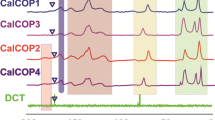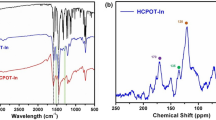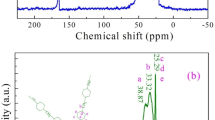Abstract
Three novel indole-based porous organic polymers (I3CA-POP, TAT-POP and Isatin-POP) were prepared for iodine adsorption from aqueous solution. It is worth noting that a polymerization process accompanying decarboxylation and a new method of constructing tertiary carbon center by ethanol and chloroform were proposed in the preparation of I3CA-POP and TAT-POP, respectively. In addition, our results indicate that I3CA-POP outperforms other sorbents in both I2 aqueous solution and KI3 aqueous solution. More importantly, the adsorption kinetics, thermodynamics, regeneration and mechanism studies of I3CA-POP were performed, demonstrating that physisorption and chemisorption may proceed at the same time in the iodine removal process.





















Similar content being viewed by others
References
Yu Y, Yin Z, Cao L, Ma Y (2022) Organic porous solid as promising iodine capture materials. J Incl Phenom Macro 102(5/6):395–427
Sun Q, Aguila B, Ma S (2019) Opportunities of porous organic polymers for radionuclide sequestration. Trends Chem 1(3):292–303
Tesfay Reda A, Pan M, Zhang D, Xu X (2021) Bismuth-based materials for iodine capture and storage: a review. J Environ Chem Eng 9(4):105279
Xie W, Cui D, Zhang S, Xu Y, Jiang D (2019) Iodine capture in porous organic polymers and metal-organic frameworks materials. Mater Horiz 6(8):1571–1595
Qin J, Zhang W, Chen Y, Liu R, Fan Y (2021) Zinc-based triazole metal complexes for efficient iodine adsorption in water. Environ Sci Pollut R 28(22):28797–28807
Gogia A, Das P, Mandal SK (2020) Tunable strategies involving flexibility and angularity of dual linkers for a 3D metal-organic framework capable of multimedia iodine capture. ACS Appl Mater Interfaces 12(41):46107–46118
El-Shahat M, Abdelhamid AE, Abdelhameed RM (2020) Capture of iodide from wastewater by effective adsorptive membrane synthesized from MIL-125-NH2 and cross-linked chitosan. Carbohyd Polym 231:115742
Liu R, Zhang W, Chen Y, Xu C, Hu G, Han Z (2020) Highly efficient adsorption of iodine under ultrahigh pressure from aqueous solution. Sep Purif Technol 233:115999
Qu G, Han Y, Qi J, Xing X, Hou M, Sun Y, Wang X, Sun G (2021) Rapid iodine capture from radioactive wastewater by green and low-cost biomass waste derived porous silicon-carbon composite. RSC Adv 11(9):5268–5275
Zhang Q, Zhai T, Wang Z, Cheng G, Ma H, Zhang Q, Zhao Y, Tan B, Zhang C (2019) Hyperporous carbon from triptycene-based hypercrosslinked polymer for iodine capture. Adv Mater Interfaces 6(9):1900249
Huang M, Yang L, Li X, Chang G (2020) An indole-derived porous organic polymer for the efficient visual colorimetric capture of iodine in aqueous media via the synergistic effects of cation-π and electrostatic forces. Chem Commun 56(9):1401–1404
Cao J, Zhu H, Shangguan L, Liu Y, Liu P, Li Q, Wu Y, Huang F (2021) A pillar[5]arene-based 3D polymer network for efficient iodine capture in aqueous solution. Polym Chem-UK 12(24):3517–3521
Li B, Wang B, Huang X, Dai L, Cui L, Li J, Jia X, Li C (2019) Terphen[n]arenes and quaterphen[n]arenes (n=3-6): one-pot synthesis, self-assembly into supramolecular gels, and iodine capture. Angew Chem Int Edit 58(12):3885–3889
Lin Y, Jiang X, Kim ST, Alahakoon SB, Hou X, Zhang Z, Thompson CM, Smaldone RA, Ke C (2017) An elastic hydrogen-bonded cross-linked organic framework for effective iodine capture in water. J Am Chem Soc 139(21):7172–7175
Zheng Z, Lin Q, Xie L, Chen X, Zhou H, Lin K, Zhang D, Chi XD, Sessler JL, Wang HY (2023) Macrocycle polymeric networks based on a chair-like calix[4]pyrrole for the rapid and efficient adsorption of iodine from water. J Mater Chem A
Gao R, An B, Zhou C, Zhang X (2022) Synthesis of a Triazaisotruxene-based porous organic polymer and its application in iodine capture. Molecules 27:8722
Zhang Z, Li L, An D, Li H, Zhang X (2020) Triazine-based covalent organic polycalix[4] arenes for highly efficient and reversible iodine capture in water. J Mater Sci 55(4):1854–1864
Wang Y, Zhao M, Zhang L, Chen Y (2021) Covalent organic polymers are highly effective absorbers of iodine in water under ultra-high pressure. J Radioanal Nucl Ch 329(3):1407–1415
Xie L, Zheng Z, Lin Q, Zhou H, Ji X, Sessler JL, Wang H (2022) Calix[4]pyrrole-based crosslinked polymer networks for highly effective iodine adsorption from water. Angew Chem Int Edit 61(1):e202113724
An D, Li L, Zhang Z, Asiri AM, Alamry KA, Zhang X (2020) Amino-bridged covalent organic Polycalix[4]arenes for ultra efficient adsorption of iodine in water. Mater Chem Phys 239:122328
Chen R, Hu T, Li Y (2021) Stable nitrogen-containing covalent organic framework as porous adsorbent for effective iodine capture from water. React Funct Polym 159:104806
Sen A, Sharma S, Dutta S, Shirolkar MM, Dam GK, Let S, Ghosh SK (2021) Functionalized ionic porous organic polymers exhibiting high iodine uptake from both the vapor and aqueous medium. ACS Appl Mater Interfaces 13(29):34188–34196
Avais M, Chattopadhyay S (2022) Porous polyaminoamides via an exotemplate synthesis approach for ultrahigh multimedia iodine adsorption. J Mater Chem A 10:20090–20100
Xu X, Li Y, Zhou L, Liu N, Wu Z (2022) Precise fabrication of porous polymer frameworks using rigid polyisocyanides as building blocks: from structural regulation to efficient iodine capture. Chem Sci 13:1111–1118
Shang Z, Pu F, Zhang X, Jin H, Chen S, Ding Y, Hu A (2023) A hyper-cross-linked aerogel with rigid conjugated polymers as building blocks for efficient iodine capture. ACS Appl Polym Mater 5(5):3827–3834
Liu B, Mao C, Zhou Z, Wang Q, Zhou X, Liao Z, Deng R, Liu D, Beiyuan J, Lv D, Li J, Huang L, Chen X, Yuan W (2023) Two facile aniline-based hypercrosslinked polymer adsorbents for highly efficient iodine capture and removal. Int J Mol Sci 24:370
Kiruthika J, Arunachalam M (2022) Pillar[5]arene-based cross-linked polymer for the rapid adsorption of iodine from water and vapor phases. Polymer 259:125322
Wang J, Wang X, Deng Y, Wu T, Chen J, Liu J, Xu L, Zang Y (2023) Preparation of an electron-rich polyimide-based hypercrosslinked polymer for high-efficiency and reversible iodine capture. Polymer 267:125665
Chen D, Ma T, Zhao X, Jing X, Zhao R, Zhu G (2022) Multi-functionalization integration into the electrospun nanofibers exhibiting effective iodine capture from water. ACS Appl Mater Interfaces 14:47126–47135
Jie K, Chen H, Zhang P, Guo W, Li M, Yang Z, Dai S (2018) A benzoquinone-derived porous hydrophenazine framework for efficient and reversible iodine capture. Chem Commun 54:12706–12709
Saleh M, Lee HM, Kemp KC, Kim KS (2014) Highly stable CO2/N2 and CO2/CH4 selectivity in hyper-cross-linked heterocyclic porous polymers. ACS Appl Mater Interfaces 6(10):7325–7333
Wang Y, Zhang L, Yang L, Ma Y, Chang G (2019) A recyclable indole-based polymer for trinitrotoluene adsorption via synergistic effect of dipole-π and donor-acceptor interactions. Polym Chem-UK 10:4632–4636
Liu C, Jin Y, Wang R, Han T, Liu X, Wang B, Huang C, Zhu S, Chen J (2020) Indole carbonized polymer dots boost full-color emission by regulating surface state. iScience 23:101546
Milakin KA, Morávková Z, Konefał R, Gupta S, Acharya U, WalterováZ BP (2022) Optimization of oxidant for polymerization of indole in water-ethanol medium. Polymer 239:124447
He Q, Xu Y, Yang X (2019) Facile synthesis aminated indole-based porous organic polymer for highly selective capture CO2 by the coefficient effect of π-π-stacking and hydrogen bonding. RSC Adv 9:11851–11854
Yang P, Yang L, Wang Y, Song L, Yang J, Chang G (2019) An indole-based aerogel for enhanced removal of heavy metals from water via the synergistic effects of complexation and cation-π interactions. J Mater Chem A 7:31–539
Wang Y, Luo X, Zhang L, Zhang S, Zhang L (2019) A reversible, colorimetric, pH-responsive indolebased hydrogel and its application in urea detection. RSC Adv 9:24299–24304
Bai J, Ma X, Yan H, Zhu J, Wang K, Wang J (2020) A novel functional porous organic polymer for the removal of uranium from wastewater. Micropor Mesopor Mat 306:110441
Wang Y, Liu X, Xie Y, Chen B, Zhang Y (2022) Effective and rapid adsorption of uranium via synergy of complexation and cation-π interaction. J Radioanal Nucl Ch 331:1115–1126
Chang G, Shang Z, Yu T, Yang L (2016) Rational design of a novel indole-based microporous organic polymer: enhanced carbondioxide uptake via local dipole-π interactions. J Mater Chem A 4:2517–2523
Wei W, Chang G, Xu Y, Yang L (2018) Indole-based conjugated microporous polymer: a new and stable lithium storage anode with high-capacity and long-life induced by cation-π interaction and N-rich aromatic structure. J Mater Chem A 6:18794–18798
Arza CR, Zhang B (2019) Synthesis, thermal properties, and rheological characteristics of indole-based aromatic polyesters. ACS Omega 4(12):15012–15021
Wang Q, Li R, Ouyang X, Wang G (2019) A novel indole-based conjugated microporous polymer for high effective removal of heavy metals from aqueous solution via double cation-π interactions. RSC Adv 9:40531–40535
Du M, Peng Y, Ma Y, Yang L, Zhou Y, Zeng F, Wang X, Song M, Chang G (2020) Selective carbon dioxide capture in antifouling indole-based microporous organic polymers. Chin J Polym Sci 38:187–194
Yuan K, Jiang L, Zhang J, Zhang J (2022) Exploration synthesis and study of indol and pyridine based heterocycle porous organic polytriazine for highly efficient iodine capture. J Porous Mat 29:405–413
Dong B, Shi T, Lu Y (2020) Multicolor conjugated polymers containing thiophene/indole moieties and the influence of structures on their photophysical properties. Polymer 206:122820
Wang P, Linares-Pasten JA, Zhang B (2020) Synthesis, molecular docking simulation, and enzymatic degradation of AB-type indole-based polyesters with improved thermal properties. Biomacromol 21:1078–1090
Xiong T, Lee WSV, Chen L, Tan TL, Huang X, Xue J (2017) Indole-based conjugated macromolecule as redoxmediated electrolyte for ultrahigh power supercapacitor. Energy Environ Sci 10:2441–2449
Urakami H, Zhang K, Vilela F (2013) Modification of conjugated microporous poly-benzothiadiazole for photosensitized singlet oxygen generation in water. Chem Commun 49:2353–2355
Xu M, Wang T, Gao P, Zhao L, Zhou L, Hua D (2019) Highly fluorescent conjugated microporous polymers for concurrent adsorption and detection of uranium. J Mater Chem A 7:11214–11222
Li X, Wang C, Lai W, Huang W (2016) Triazatruxene-based materials for organic electronics and optoelectronics. J Mater Chem C 4:10574–10587
Bogdanov AV, Mironov VF (2018) Advances in the synthesis of isatins: a survey of the last decade. Synthesis 50(08):1601–1609
Sadak AE, Karakus E, Chumakov YM, Dogan NA (2020) Yavuz CT (2020) Triazatruxene-based ordered porous polymer: high capacity CO2, CH4, and H2 capture, heterogeneous suzuki-miyaura catalytic coupling, and thermoelectric properties. ACS Appl Energy Mater 3:4983–4994
Rakstys K, Abate A, Dar MI, Gao P, Jankauskas V, Jacopin G, Kamarauskas E, Kazim S, Ahmad S, Grätzel M, Nazeeruddin MK (2015) Triazatruxene-based hole transporting materials for highly efficient perovskite solar cells. J Am Chem Soc 137:16172–16178
Ginnari-Satriani L, Casagrande V, Bianco A, Ortaggi G, Franceschin M (2009) A hydrophilic three side-chained triazatruxene as a new strong and selective G-quadruplex ligand. Org Biomol Chem 7:2513–2516
Chen G, Zhao Q, Wang Z, Jiang M, Zhang L, Duan T, Zhu L (2022) Pitch-based porous polymer beads for highly efficient iodine capture. J Hazard Mater 434:128859
Ivanets A, Milyutin V, Shashkova I, Kitikova N, Nekrasova N, Radkevich A (2020) Sorption of stable and radioactive Cs(I), Sr(II), Co(II) ions on Ti–Ca–Mg phosphates. J Radioanal Nucl Chem 324:1115–1123
Liu B, Ren X, Chen L, Ma X, Chen Q, Sun Q, Zhang L, Si P, Ci L (2019) High efficient adsorption and storage of iodine on S, N co-doped graphene aerogel. J Hazard Mater 373:705–715
Hikawa H, Kotaki F, Kikkawa S, Azumaya I (2019) Gold(III)-catalyzed decarboxylative C3-benzylation of indole-3-carboxylic acids with benzylic alcohols in water. J Org Chem 84(4):1972–1979
Zhu J, Chen Q, Sui Z, Pan L, Yu J, Han B (2014) Preparation and adsorption performance of cross-linked porous polycarbazoles. J Mater Chem A 2:16181–16189
Zhang C, Zhu P, Tan L, Liu J, Tan B, Yang X, Xu H (2015) Triptycene-based hyper-cross-linked polymer sponge for gas storage and water treatment. Macromolecules 48:8509–8514
Chen D, Fu Y, Yu W, Yu G, Pan C (2018) Versatile Adamantane-based porous polymers with enhanced microporosity for efficient CO2 capture and iodine removal. Chem Eng J 334:900–906
Kouznetsova T, Sauka J, Ivanets A (2021) Template synthesis and gas adsorption properties of ordered mesoporous aluminosilicates. Appl Nanosci 11:1903–1915
Pang P, Han H, Hu L, Guo C, Gao Y, Xie Y (2021) The calculations of pore structure parameters from gas adsorption experiments of shales: which models are better? J Nat Gas Sci Eng 94:104060
Bardestani R, Patience GS, Kaliaguine S (2019) Experimental methods in chemical engineering: specific surface area and pore size distribution measurements—BET, BJH, and DFT. Can J Chem Eng 97:2781–2791
Ryu Z, Zheng J, Wang M, Zhang B (1999) Characterization of pore size distributions on carbonaceous adsorbents by DFT. Carbon 37:1257–1264
Ho YS, McKay G (1999) Pseudo-second order model for sorption processes. Process Biochem 34(5):451–465
Khamizov RK (2020) A pseudo-second order kinetic equation for sorption processes. Russ J Phys Chem A 94:171–176
Qian X, Zhu Z, Sun H, Ren F, Mu P, Liang W, Chen L, Li A (2016) Capture and reversible storage of volatile iodine by novel conjugated microporous polymers containing thiophene units. ACS Appl Mater Inter 8:21063–21069
Huang Y, Li W, Xu Y, Ding M, Ding J, Zhang Y, Wang Y, Chen S, Jin Y, Xia C (2021) Rapid iodine adsorption from vapor phase and solution by a nitrogen-rich covalent piperazine-triazine-based polymer. New J Chem 45(12):5363–5370
Wang Y, Tao J, Xiong S, Lu P, Tang J, He J, Javaid MU, Pan C, Yu G (2020) Ferrocene-based porous organic polymers for high-affinity iodine capture. Chem Eng J 380:122420
Xu M, Wang T, Zhou L, Hua D (2020) Fluorescent conjugated mesoporous polymers with N, N-diethylpropylamine for the efficient capture and real-time detection of volatile iodine. J Mater Chem A 8(4):1966–1974
Wang C, Wang Y, Ge R, Song X, Xing X, Jiang Q, Lu H, Hao C, Guo X, Gao Y, Jiang D (2018) A 3D covalent organic framework with exceptionally high iodine capture capability. Chem-Eur J 24(3):585–589
Lin J, Liang J, Feng J, Karadeniz B, Lü J, Cao R (2016) Iodine uptake and enhanced electrical conductivity in a porous coordination polymer based on cucurbit[6]uril. Inorg Chem Front 3(11):1393–1397
De Wall SL, Meadows ES, Barbour LJ, Gokel GW (1999) Solution- and solid-state evidence for alkali metal cation−π interactions with indole, the side chain of tryptophan. J Am Chem Soc 121:5613–5614
Schlamadinger DE, Daschbach MM, Gokel GW, Kim JE (2011) UV resonance raman study of cation-π interactions in an indole crown ether. J Raman Spectrosc 42(4):633–638
Svensson PH, Kloo L (2003) Synthesis, structure, and bonding in polyiodide and metal iodide−iodine systems. Chem Rev 103(5):1649–1684
Acknowledgements
This work was supported by National Natural Science Foundation of China (21978188, 22278294, 21506143); Natural Science Foundation of Shanxi Province (20210302123191); Scientific and Technologial Innovation Programs of Higher Education Institutions in Shanxi (2022L602).
Funding
National Natural Science Foundation of China,21978188,Jie Mi,22278294,Mengmeng Wu,21506143,Mengmeng Wu,Natural Science Foundation of Shanxi Province,20210302123191,Mengmeng Wu,Scientific and Technologial Innovation Programs of Higher Education Institutions in Shanxi,2022L602,Luna Song
Author information
Authors and Affiliations
Corresponding authors
Ethics declarations
Conflict of interest
The authors declare that they have no known competing financial interests or personal relationships that could have appeared to influence the work reported in this paper.
Data availability
Data will be made available on request.
Additional information
Publisher's Note
Springer Nature remains neutral with regard to jurisdictional claims in published maps and institutional affiliations.
Supplementary Information
Below is the link to the electronic supplementary material.
Rights and permissions
Springer Nature or its licensor (e.g. a society or other partner) holds exclusive rights to this article under a publishing agreement with the author(s) or other rightsholder(s); author self-archiving of the accepted manuscript version of this article is solely governed by the terms of such publishing agreement and applicable law.
About this article
Cite this article
Yu, J., Song, L., Wang, Y. et al. Three novel indole-based porous organic polymers for efficient iodine capture in water. J Radioanal Nucl Chem 332, 4271–4290 (2023). https://doi.org/10.1007/s10967-023-09115-9
Received:
Accepted:
Published:
Issue Date:
DOI: https://doi.org/10.1007/s10967-023-09115-9




